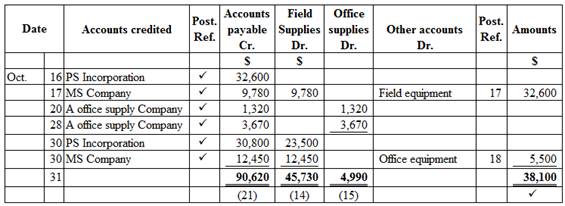
1.
Prepare a single column revenue journal and cash receipt journal, and post the accounts in the accounts payable subsidiary ledger.
1.
Explanation of Solution
General Ledger: General ledger refers to the ledger that records all the transactions of the business related to the company’s assets, liabilities, owners’ equities, revenues, and expenses. Each subsidiary ledger is represented in the general ledger by summarizing the account.
Accounts payable control account and subsidiary ledger: Accounts payable account and subsidiary ledger is the ledger which is used to post the creditors transaction in one particular ledger account. It helps the business to locate the error in the creditor ledger balance. After all transactions of creditor accounts are posted, the balances in the accounts payable subsidiary ledger should be totaled, and compare with the balance in the general ledger of accounts payable. If both the balance does not agree, the error has been located and corrected.
Purchase journal: Purchase journal refers to the journal that is used to record all purchases on account. In the purchase journal, all purchase transactions are recorded only when the business purchased the goods on account. For example, the business purchased cleaning supplies on account.
Cash payments journal: Cash payments journal refers to the journal that is used to record all transaction which involves the cash payments. For example, the business paid cash to employees (salary paid to employees).
Purchase journal: Purchase journal of Company WTE in the month of October is as follows:
Purchase journal

Figure (1)
Cash payment journal: Cash payment journal of Company WTE in the month of October is as follows:
Cash payment journal
| Date | Check No. | Account debited | Post Ref. | Other accounts Dr. | Accounts payable Dr. | Cash Dr. | |
| Oct. | 16 | 1 | Rent expense | 71 | 7,000 | 7,000 | |
| 18 | 2 | Field supplies | 14 | 4,570 | 4,570 | ||
| Office supplies | 15 | 650 | 650 | ||||
| 24 | PS Incorporation | ✓ | 32,600 | 32,600 | |||
| 26 | MS Company | ✓ | 9,780 | 9,780 | |||
| 28 | Land | 240,000 | 240,000 | ||||
| 30 | A Office supply Company | ✓ | 1,320 | 1,320 | |||
| 31 | Salary expense | 61 | 32,000 | 32,000 | |||
| 31 | 284,220 | 43,700 | 327,920 | ||||
| ✓ | (21) | (11) | |||||
Table (1)
Accounts payable subsidiary ledger
| Name: A Office supply Company | ||||||
| Date | Item | Post. Ref |
Debit ($) | Credit ($) |
Balance ($) | |
| Oct. | 20 | P1 | 1,320 | 1,320 | ||
| 28 | P1 | 3,670 | 4,990 | |||
| 30 | CP1 | 1,320 | 3,670 | |||
Table (2)
| Name: MS Company | ||||||
| Date | Item | Post. Ref |
Debit ($) | Credit ($) |
Balance ($) | |
| Oct. | 17 | P1 | 9,780 | 9,780 | ||
| 26 | CP1 | 9,780 | - | |||
| 30 | P1 | 12,450 | 12,450 | |||
Table (3)
| Name: PS Incorporation | ||||||
| Date | Item | Post. Ref |
Debit ($) | Credit ($) |
Balance ($) | |
| Oct. | 16 | P1 | 32,600 | 32,600 | ||
| 24 | CP1 | 32,600 | - | |||
| 30 | P1 | 30,800 | 30,800 | |||
Table (4)
2. and 3.
2. and 3.
Explanation of Solution
Prepare the general ledger for given accounts as follows:
| Account: Cash Account no. 11 | |||||||
| Date | Item | Post. Ref |
Debit ($) | Credit ($) | Balance | ||
| Debit ($) | Credit ($) | ||||||
| Oct. | 31 | CP1 | 327,920 | 327,920 | |||
Table (5)
| Account: Field supplies Account no. 14 | |||||||
| Date | Item | Post. Ref |
Debit ($) | Credit ($) | Balance | ||
| Debit ($) | Credit ($) | ||||||
| Oct. | 18 | CP1 | 4,570 | 4,570 | |||
| 31 | P1 | 47,530 | 52,100 | ||||
Table (6)
| Account: Office supplies Account no. 15 | |||||||
| Date | Item | Post. Ref |
Debit ($) | Credit ($) | Balance | ||
| Debit ($) | Credit ($) | ||||||
| Oct. | 18 | CP1 | 650 | 650 | |||
| 31 | P1 | 4,990 | 5,460 | ||||
Table (7)
| Account: Prepaid rent Account no. 16 | |||||||
| Date | Item | Post. Ref |
Debit ($) | Credit ($) | Balance | ||
| Debit ($) | Credit ($) | ||||||
| Oct. | 31 | J1 | 15,000 | 15,000 | |||
Table (8)
| Account: Field equipment Account no. 17 | |||||||
| Date | Item | Post. Ref |
Debit ($) | Credit ($) | Balance | ||
| Debit ($) | Credit ($) | ||||||
| Oct. | 16 | P1 | 32,600 | 32,600 | |||
| 31 | J1 | 15,000 | 17,600 | ||||
Table (9)
| Account: Office equipment Account no. 18 | |||||||
| Date | Item | Post. Ref |
Debit ($) | Credit ($) | Balance | ||
| Debit ($) | Credit ($) | ||||||
| 31 | P1 | 5,500 | 5,500 | ||||
Table (10)
| Account: Land Account no. 19 | |||||||
| Date | Item | Post. Ref |
Debit ($) | Credit ($) | Balance | ||
| Debit ($) | Credit ($) | ||||||
| Oct. | 23 | CP1 | 240,000 | 240,000 | |||
Table (11)
| Account: Accounts payable Account no. 21 | |||||||
| Date | Item | Post. Ref |
Debit ($) | Credit ($) | Balance | ||
| Debit ($) | Credit ($) | ||||||
| Oct. | 31 | P1 | 90,620 | 90,620 | |||
| 31 | CP1 | 43,700 | 46,920 | ||||
Table (12)
| Account: Salary expense Account no. 61 | |||||||
| Date | Item | Post. Ref |
Debit ($) | Credit ($) | Balance | ||
| Debit ($) | Credit ($) | ||||||
| Oct. | 31 | CP1 | 32,000 | 32,000 | |||
Table (13)
| Account: Rent expense Account no. 71 | |||||||
| Date | Item | Post. Ref |
Debit ($) | Credit ($) | Balance | ||
| Debit ($) | Credit ($) | ||||||
| Oct. | 16 | CP1 | 7,000 | 7,000 | |||
Table (14)
| Journal Page 01 | |||||
| Date | Description | Post. Ref | Debit ($) | Credit ($) | |
| Oct. | 31 | Prepaid rent | 16 | 15,000 | |
| Field equipment | 17 | 15,000 | |||
| (To record leasing of field equipment) | |||||
Table (15)
4.
Prepare accounts payable creditor balances.
4.
Explanation of Solution
Accounts payable creditor balance
Accounts payable creditor balance is as follows:
| Company WTE | |
| Accounts payable creditor balances | |
| October 31 | |
| Amount ($) | |
| A Office supply Company | 3,670 |
| MS Company | 12,450 |
| PS Incorporation | 30,800 |
| Total accounts receivable | 46,920 |
Table (16)
Accounts payable controlling account
Ending balance of accounts payable controlling account is as follows:
| Company WTE | |
| Accounts payable (Controlling account) | |
| October 31 | |
| Amount ($) | |
| Opening balance | 0 |
| Add: | |
| Total credits (from purchase journal) | 90,620 |
| 90,620 | |
| Less: | |
| Total debits (from cash payment journal) | (43,700) |
| Total accounts payable | 46,920 |
Table (17)
In this case, accounts payable subsidiary ledger is used to identify, and locate the error by way of cross-checking the creditor balance and accounts payable controlling account. From the above calculation, we can understand that both balances of accounts payable is agree, hence there is no error in the recording and posing of transactions.
5.
Discuss the reason for using subsidiary ledger for the field equipment.
5.
Explanation of Solution
A subsidiary ledger for the field equipment helps the company to track the cost of each piece of equipment, location, useful life, and other necessary data. This information is used for safeguarding the equipment and determining depreciation of equipment.
Want to see more full solutions like this?
Chapter 5 Solutions
FINANCIAL ACCOUNTING
- Hello tutor please given General accounting question answer do fast and properly explain all answerarrow_forwardCan you help me solve this general accounting problem using the correct accounting process?arrow_forwardNorwin Co. sells its product for $40 per unit. The variable cost per unit is $24, and fixed costs total $160,000 per year. Last year, the company sold 15,000 units. This year, the company is expecting to increase sales volume to 17,000 units. What is the expected change in operating income due to the increase in sales volume?arrow_forward
- Nonearrow_forwardGeneral accountingarrow_forwardFor Caesar Manufacturing, the predetermined overhead rate is 135% of direct labor cost. During the month, Caesar incurred $142,000 in factory labor costs, of which $105,300 is direct labor and $36,700 is indirect labor. The actual overhead incurred was $136,400. Compute the amount of manufacturing overhead applied during the month. Determine the amount of under- or overapplied manufacturing overhead.arrow_forward
- Please explain the solution to this general accounting problem with accurate principles.arrow_forwardstep by step answerarrow_forwardThe Work in Process inventory account of Elysium Manufacturing shows a balance of $12,700 at the end of the accounting period. The job cost sheets of three uncompleted jobs show charges of $900, $750, and $650 for materials, and charges of $1,100, $950, and $800 for direct labor. From this information, it appears that the company is using a predetermined overhead rate, as a percentage of direct labor costs, of _.arrow_forward
 Financial AccountingAccountingISBN:9781337272124Author:Carl Warren, James M. Reeve, Jonathan DuchacPublisher:Cengage Learning
Financial AccountingAccountingISBN:9781337272124Author:Carl Warren, James M. Reeve, Jonathan DuchacPublisher:Cengage Learning Excel Applications for Accounting PrinciplesAccountingISBN:9781111581565Author:Gaylord N. SmithPublisher:Cengage Learning
Excel Applications for Accounting PrinciplesAccountingISBN:9781111581565Author:Gaylord N. SmithPublisher:Cengage Learning College Accounting (Book Only): A Career ApproachAccountingISBN:9781305084087Author:Cathy J. ScottPublisher:Cengage LearningCentury 21 Accounting Multicolumn JournalAccountingISBN:9781337679503Author:GilbertsonPublisher:CengagePrinciples of Accounting Volume 1AccountingISBN:9781947172685Author:OpenStaxPublisher:OpenStax College
College Accounting (Book Only): A Career ApproachAccountingISBN:9781305084087Author:Cathy J. ScottPublisher:Cengage LearningCentury 21 Accounting Multicolumn JournalAccountingISBN:9781337679503Author:GilbertsonPublisher:CengagePrinciples of Accounting Volume 1AccountingISBN:9781947172685Author:OpenStaxPublisher:OpenStax College





